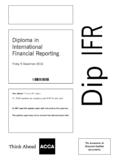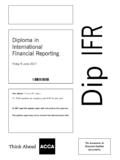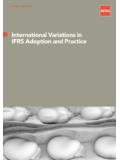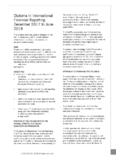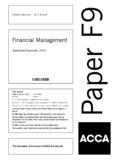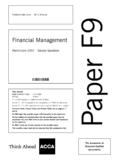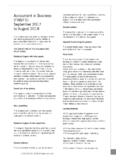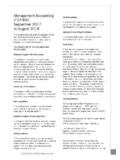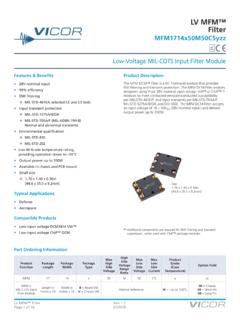Transcription of ADVANCED INVESTMENT APPRAISAL - ACCA Global
1 RELEVANT TO ACCA QUALIFICATION PAPER F9 Studying Paper F9? Performance objectives 15 and 16 are relevant to this exam 2010 ACCA ADVANCED INVESTMENT APPRAISAL INVESTMENT APPRAISAL is one of the eight core topics within Paper F9, Financial Management and it is a topic which has been well represented in the F9 exam. The methods of INVESTMENT APPRAISAL are payback, accounting rate of return and the discounted cash flow methods of net present value (NPV) and internal rate of return (IRR). For each of these methods students must ensure that they can define it, make the necessary calculations and discuss both the advantages and disadvantages. The most important of these methods, both in the real world and in the exam, is NPV. A key issue in the Paper F9 syllabus is that students start their studies with no knowledge of discounting but are very rapidly having to deal with relatively ADVANCED NPV calculations which may include problems such as inflation, taxation, working capital and relevant/irrelevant cash flows.
2 These ADVANCED NPV or indeed IRR calculations have formed the basis for very many past exam questions. The aim of this article is to briefly discuss these potential problem areas and then work a comprehensive example which builds them all in. Technically the example is probably harder than any exam question is likely to be. However, it demonstrates as many of the issues that students might face as is possible. Exam questions, on the other hand, will be in a scenario format and hence finding the information required may be more difficult than in the example shown. The problem areas Inflation Students must be aware of the two different methods of dealing with inflation and when they should be used. The money method is where inflation is included in both the cash flow forecast and the discount rate used while the real method is where inflation is ignored in both the cash flow forecast and the discount rate.
3 The money method should be used as soon as a question has cash flows inflating at different rates or where a question involves both tax and inflation. Because of this the money method is commonly required. Students must ensure that they can use the Fisher formula provided to calculate a money cost of capital or indeed a real cost of capital for discounting purposes. They must also be able to distinguish between a general inflation rate which will impact on the money cost of capital and potentially some cash flows and a specific inflation rate which only applies to particular cash flows. 2 ADVANCED INVESTMENT APPRAISAL OCTOBER 2010 2010 ACCA Taxation Building taxation into a discounted cash flow answer involves dealing with the good the bad and the ugly !
4 The good news with taxation is that tax relief is often granted on the INVESTMENT in assets which leads to tax saving cash flows. The bad news is that where a project makes net revenue cash inflows the tax authorities will want to take a share of them. The ugly issue is the timing of these cash flows as this is an area which often causes confusion. Working capital The key issue that must be remembered here is that an increase in working capital is a cash outflow. If a company needs to buy more inventories, for example, there will be a cash cost. Equally a decrease in working capital is a cash inflow. Hence at the end of a project when the working capital invested in that project is no longer required a cash inflow will arise.
5 Students must recognise that it is the change in working capital that is the cash flow. There is often concern amongst students that the inventories purchased last year will have been sold and hence must be replaced. However, to the extent the items have been sold their cost will be reflected elsewhere in the cash flow table. Relevant/irrelevant cash flows This problem is rarely a big issue in Paper F9 as students have been examined on this topic previously. However students should remember the Golden Rule which states that to be included in a cash flow table an item must be a future, incremental cash flow. Irrelevant items to look out for are sunk costs such as amounts already spent on research and apportioned or allocated fixed costs.
6 Equally all financing costs should be ignored as the cost of financing is accounted for in the discount rate used. Having reminded you of the potential problem areas let us now consider a comprehensive example: CBS Co CBS Co is considering a new INVESTMENT which would start immediately and last four years. The company has gathered the following information: Asset cost $160,000 Annual sales are expected to be 30,000 units in Years 1 and 2 and will then fall by 5,000 units per year in both Years 3 and 4. The selling price in first-year terms is expected to be $ per unit and this is then expected to inflate by 3% per annum. The variable costs are expected to be $ per unit in current terms and the incremental fixed costs in the first year are expected to be $ per unit in current terms.
7 Both of these costs are expected to inflate at 5% per annum. 3 ADVANCED INVESTMENT APPRAISAL OCTOBER 2010 2010 ACCA The asset is expected to have a residual value (RV) of $40,000 in money terms. The project will require working capital INVESTMENT equal to 10% of the expected sales revenue. This INVESTMENT must be in place at the start of each year. Corporation tax is 30% per annum and is paid one year in arrears. 25% reducing balance writing-down allowances are available on the asset cost. General inflation is 4% and the real cost of capital is $12,000 has already been spent on initial research. Required: Calculate the NPV of the proposed INVESTMENT . Solution and explanatory notes: Many students fall into the trap of starting the cash flow table too quickly.
8 Initially there are a number of workings or thinkings that should be carried out. These workings can generally be carried out in any order. Once they are completed it will be possible to construct the cash flow table quickly and accurately. Before going further students must understand the difference between a T and a Year. A T is a point in time and hence T0 is now and T1 is in one-year s time. A Year is a period of time and hence Year 1 is the period between T0 and T1 and Year 2 is the period between T1 and T2. Please note T1 is both the end of Year 1 and the start of Year 2. Working 1 Inflation As the question involves both tax and inflation and has different inflation rates the money method must be used. Hence the cash flows in the cash flow table must be inflated and the discounting should then be carried out using a money cost of capital.
9 As a money cost of capital is not given it must be calculated using the Fisher formula: (1 + i) = (1 + ) x (1 + ) = Therefore, i the money cost of capital is or 12% Note: The real rate (r) of and the general inflation rate (h) of 4% must be expressed as decimals when using the Fisher formula 4 ADVANCED INVESTMENT APPRAISAL OCTOBER 2010 2010 ACCA Working 2 Tax savings on the writing-down allowances (WDA) Year TWDV - $ 000 Tax saving at 30% Timing Asset cost 1 25% WDA ( ) T2 2 25% WDA ( )
10 T3 3 25% WDA ( ) T4 4 Balancing allowance ( ) T5 Residual value Notes: TWDV Tax written down value, WDA Writing-down allowance The examiner s normal assumption is that an asset is bought at the start of the first year of the project and hence the first WDA is available for Year 1.

